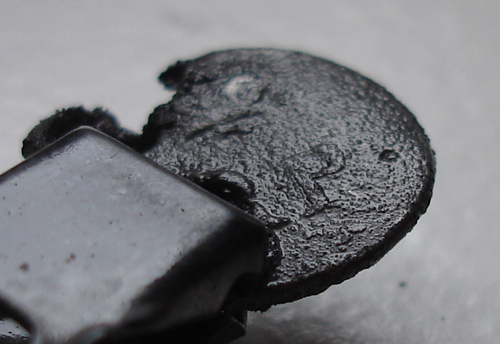
This button, with its distinctive crown and the letters “RP,” was from the uniform of a British Army regiment made up of American colonists loyal to the British crown. A button recently discovered from the Storm Wreck, with a similar crown, could help identify the shipwreck.
I often tell tour groups here at the St. Augustine Lighthouse & Museum that many of our discoveries are not made on the seafloor, but in the laboratory. Nothing exemplifies this statement more than a tiny little button that was recently found by one of our volunteers while cleaning away the concretion from the ship’s bell. It is a small find, but one which might possibly lead to a positive identity for this shipwreck, and one which is already leading to a better understanding of this mystery ship’s date, nationality, and function.
The story of the button broke in a St. Augustine Record front page story on 23 July. We actually discovered the button a week or two earlier.
From the Record:
“It’s in rough shape,” Sam Turner, director of archaeology at the St. Augustine Lighthouse and Museum, said of the button.
Even so, the top part of a crown can be seen on the button and similar crowns are found on Royal Provincial buttons plus the initials RP. Those were on the uniforms of men in the Loyalist regiments, the colonists who remained loyal to the Crown during the American Revolution.
“When our button is cleaned you hope to find RP or part of one (of the letters),” Turner said.
That would be a big step forward in identifying the wreck discovered a few miles off the St. Augustine Inlet in the summer of 2009.
One of the hypotheses archaeologists have been working under is that the ship could be part of a fleet carrying Loyalists to St. Augustine after the fall of Charleston to the Americans. Over a two-day period 16 ships were reported wrecked off the sandbar in December of 1782.
Provincials were soldiers in the British Army, raised and maintained just for the duration of the war itself, in this case the American Revolution. They were paid, clothed, and disciplined like any other British soldier. Any of a number of Provincial units or regiments across the colonies might have featured buttons like the one pictured above on their uniforms. If it does turn out to be a Royal Provincial button, it would be a really unique clue corroborating our hypothesis that this ship was carrying loyalists, perhaps both civilians and troops, into St. Augustine at the very end of the war.

This is the actual button as it appeared shortly after being removed from concretion, the encrustation that for over a century covered the ship’s bell and entombed this little pewter button. While it is damaged, the crown can be seen to the naked eye (not easily in this photograph, however). Cleaning in the laboratory will reveal if the letters “RP” are also present.
The button is currently undergoing electrolytic cleaning side by side with other pewter objects recovered from the shipwreck (three spoons and a shoe buckle). The cleaning should reveal the letters if this indeed is a Royal Provincials button. Stay tuned to this blog so that you’ll be the first to know (other than our archaeologists and lab volunteers, at least)!
To learn more about the shipwreck, visit LAMP’s Storm Wreck webpage.
UPDATE!
Since the time of this original blog posting, we have taken a peek at the button after a few weeks of electrolysis . . . . and the “RP” we suspected was on the button can clearly be seen! We are very excited about this tiny little button as it was the first and best indicator that British Loyalists were on this vessel when it sank, which goes a long way to confirm our suspicion that this ship was one of the 16 Loyalist vessels to wreck on December 31, 1782 during the final evacuation of Charleston at the close of the American Revolution.
Below is the photograph of the cleaned button, showing the RP:

Note the clip holding the button (this photo was taken immediately after removing the button from electrolysis, where it is clipped in place) partially obscures the R, but that area is obscured regardless due to physical damage to the button.

